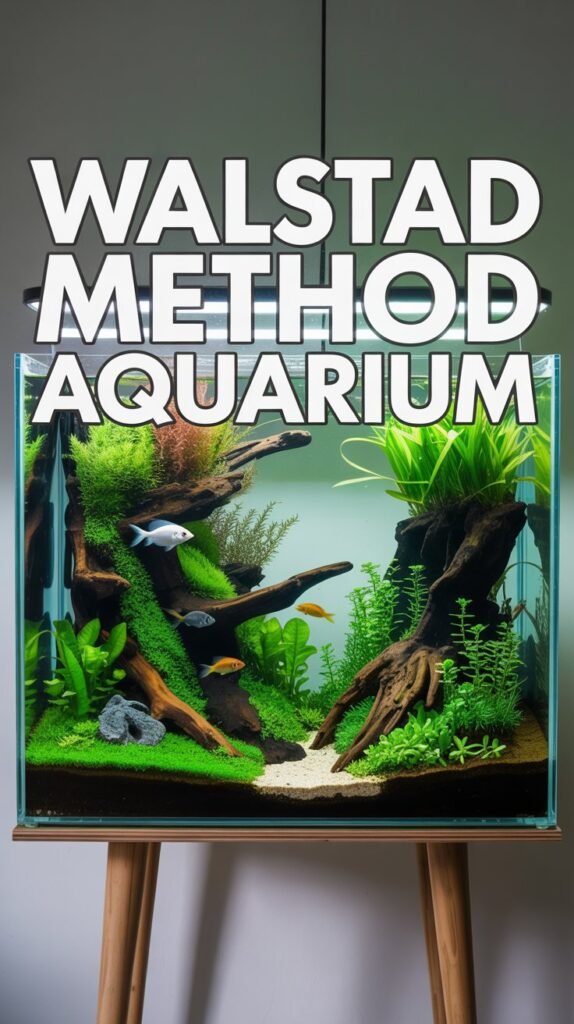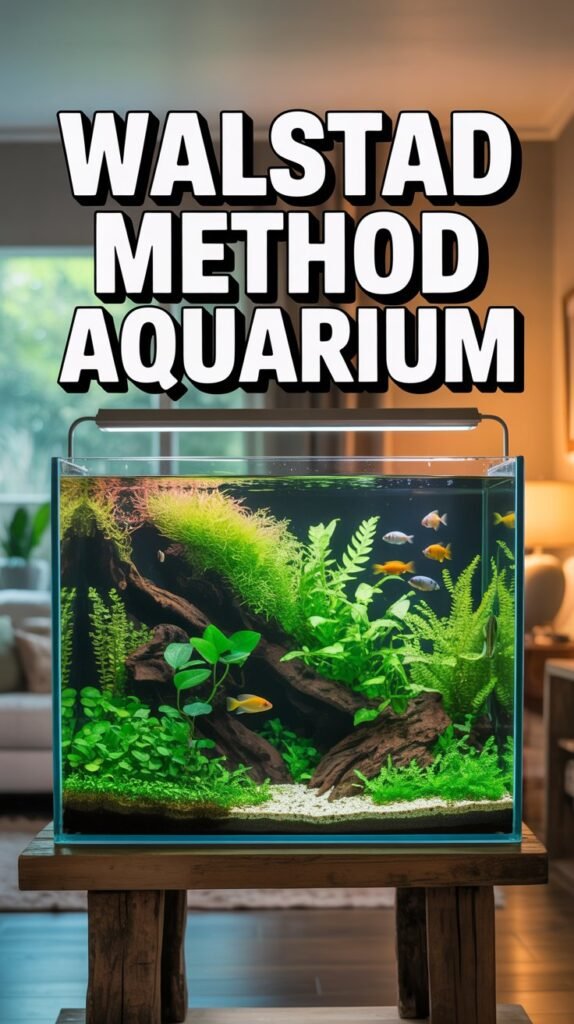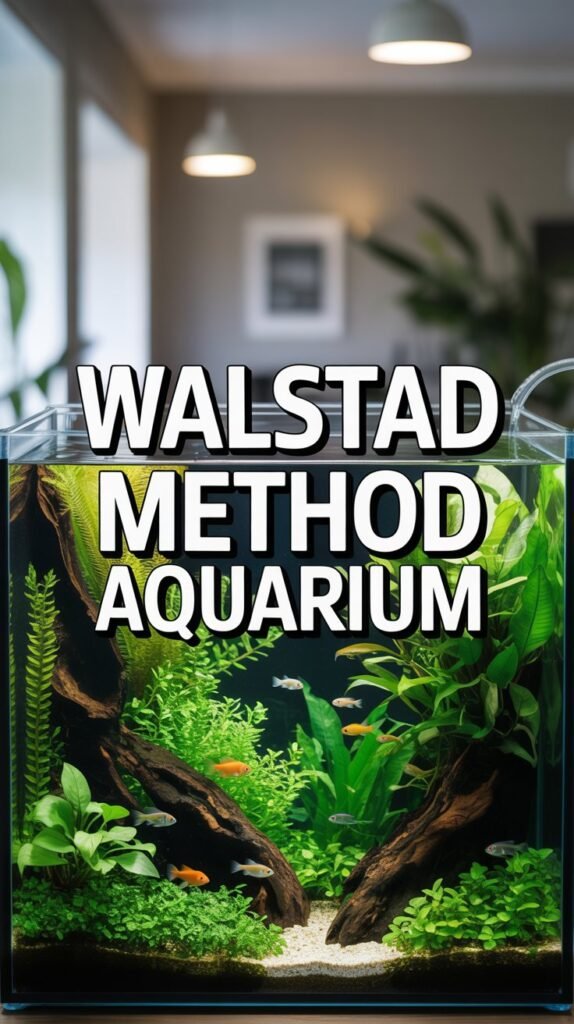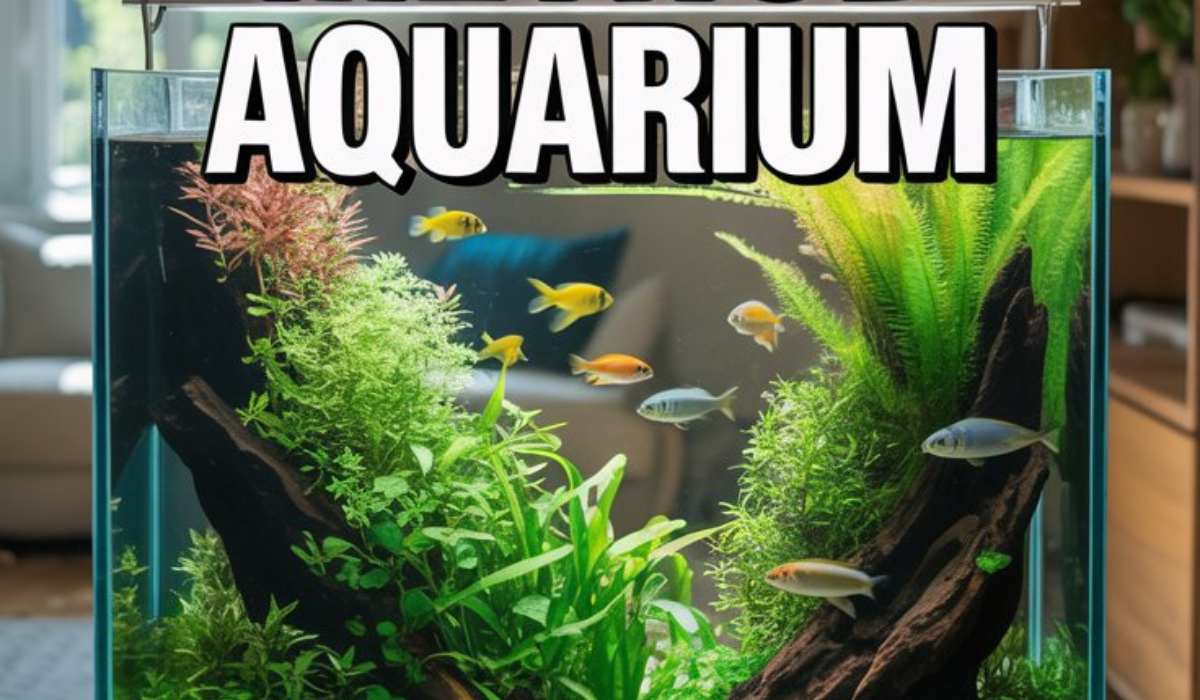The Walstad Method Aquarium is one of the most popular natural approaches to fishkeeping. It allows aquarists to create a self-sustaining, low-maintenance ecosystem where plants, fish, and microorganisms thrive together — without relying on heavy filtration, constant dosing, or complex CO₂ systems.
Developed by Diana Walstad, a microbiologist and aquarist, this method focuses on harnessing nature’s balance to keep aquariums healthy and stable. In this comprehensive guide, we’ll explore everything you need to know about setting up and maintaining a Walstad tank, from substrate choices to water parameters, lighting, and stocking tips.
What Is the Walstad Method Aquarium?
The Walstad Method Aquarium is a natural planted tank concept that replicates natural aquatic ecosystems. Instead of relying on mechanical filters or chemical fertilizers, this method uses a soil-based substrate and live plants to filter the water biologically.
The plants act as natural filters, absorbing ammonia, nitrates, and phosphates — the same compounds that mechanical filters target. The substrate, composed mainly of soil and a sand or gravel cap, provides nutrients for plant roots and supports beneficial bacteria.

Essentially, a Walstad tank creates a closed-loop ecosystem where fish waste fertilizes plants, plants purify the water, and microorganisms keep the environment balanced.
Key Principles of the Walstad Method
- Use of Soil Substrate:
The foundation of a Walstad aquarium is nutrient-rich soil. Unlike inert substrates like gravel, soil provides essential minerals and trace elements for plant growth. - No Artificial CO₂ Injection:
The system relies on natural carbon dioxide produced by fish respiration and organic matter breakdown. - Minimal Filtration:
The method encourages the use of little to no mechanical filtration. Water movement should be gentle, preserving CO₂ levels and preventing excess oxygenation. - Strong Plant Growth:
Plants are the main biofilters. Fast-growing species help absorb nutrients and stabilize the water chemistry. - Natural Lighting:
Moderate natural or artificial lighting is preferred. Excessive light can cause algae growth. - Balanced Stocking:
Fish numbers should be low enough to prevent overloading the system, but high enough to produce nutrients for plants.
Benefits of the Walstad Method Aquarium
The Walstad method has gained immense popularity among aquarists who seek a natural, sustainable aquarium system. Here are the top benefits:
1. Low Maintenance
Once established, the aquarium largely maintains itself. Water changes are minimal — typically only 25–30% monthly or even less.
2. Cost-Effective
No expensive filters, CO₂ systems, or fertilizers are required. Most of the equipment needed is basic, making it ideal for beginners or budget-conscious hobbyists.
3. Natural Ecosystem
It replicates a real aquatic ecosystem, providing a healthy environment for both fish and plants. The natural cycle of nutrients minimizes stress on inhabitants.
4. Healthier Fish
The stable and chemical-free environment promotes healthier, more colorful, and less stressed fish.
5. Environmentally Friendly
Using natural processes instead of synthetic chemicals aligns with eco-friendly aquarium keeping.
Setting Up a Walstad Method Aquarium

Creating a successful Walstad aquarium requires careful planning and understanding of natural balance. Let’s go step-by-step through the setup process.
Step 1: Choose the Right Tank Size
While you can create a Walstad setup in any size aquarium, beginners often find success with tanks between 10 to 30 gallons. Smaller tanks are more prone to fluctuations, while larger tanks are easier to stabilize.
Step 2: Prepare the Substrate
The substrate is the heart of the Walstad system.
1. Base Layer – Soil
- Use organic potting soil without fertilizers, pesticides, or perlite.
- Spread about 1 to 1.5 inches of soil at the bottom.
- You can also add clay or laterite for additional iron and minerals.
2. Top Layer – Cap
- Add 1 to 1.5 inches of fine sand or gravel to prevent the soil from clouding the water.
- The cap also prevents gas pockets and keeps nutrients in the root zone.
Step 3: Add Hardscape (Optional)
Include driftwood, rocks, or other decorations to create a natural aesthetic. Make sure they are aquarium-safe and won’t alter the water chemistry drastically.
Step 4: Fill the Aquarium
- Fill the tank slowly to avoid disturbing the soil layer.
- Place a plate or plastic bag over the substrate while pouring water to prevent cloudiness.
- Use dechlorinated water to protect beneficial bacteria and plants.
Step 5: Plant Selection
Plants are the core of this method. A mix of fast- and slow-growing species ensures balance.
Recommended Fast-Growing Plants:
- Hornwort (Ceratophyllum demersum)
- Water wisteria (Hygrophila difformis)
- Vallisneria (Vallisneria spiralis)
- Amazon sword (Echinodorus amazonicus)
Recommended Slow-Growing Plants:
- Anubias
- Java fern (Microsorum pteropus)
- Cryptocoryne species
- Bucephalandra
Plant heavily from the start — ideally, 70–80% of the substrate should be covered with plants to outcompete algae and stabilize nutrients.
Step 6: Lighting
The Walstad method emphasizes moderate lighting.
- Duration: 6–8 hours daily.
- Type: Full-spectrum LED or natural sunlight.
- Avoid direct sunlight as it can cause algae blooms.
Remember, too much light without adequate plant growth can upset the balance.
Step 7: Add Fish
After planting, wait 2–3 weeks before adding fish. This allows the plants to root and the system to stabilize.
Ideal Fish for Walstad Aquariums:
- Guppies
- Tetras
- Rasboras
- Corydoras
- Bettas (in smaller tanks)
- Shrimp and snails (for algae control)
Stock lightly — a good rule is 1 inch of fish per gallon. Overcrowding increases waste, which can overwhelm the plants.
Step 8: Maintenance
The beauty of the Walstad system lies in minimal maintenance:
- Water changes: 10–25% monthly, or only as needed.
- Filter: Optional. If used, set it to a gentle flow.
- Feeding: Avoid overfeeding. Uneaten food can disrupt the nutrient balance.
- Trimming: Regularly trim plants to prevent shading and promote new growth.
You can occasionally test for pH, ammonia, and nitrates — but if your tank looks healthy, that’s usually enough.
Water Parameters for a Walstad Aquarium
While the method is flexible, maintaining stable water parameters ensures success:
| Parameter | Ideal Range |
|---|---|
| Temperature | 22–28°C (72–82°F) |
| pH | 6.5–7.5 |
| Ammonia | 0 ppm |
| Nitrite | 0 ppm |
| Nitrate | <20 ppm |
| GH (General Hardness) | 4–12 dGH |
| KH (Carbonate Hardness) | 3–8 dKH |
Soil and driftwood can slightly lower pH, which benefits most tropical fish and plants.
The Science Behind the Walstad Method

The success of this method lies in the nitrogen cycle and plant-microbe interactions:
- Fish produce waste, releasing ammonia.
- Beneficial bacteria in the soil convert ammonia to nitrite and then to nitrate.
- Plants absorb ammonia and nitrate as nutrients, purifying the water.
- Organic matter decomposition releases CO₂, feeding plants.
- Oxygen produced by plants supports fish and microorganisms.
This natural loop eliminates the need for heavy filtration and water changes, mimicking nature’s balance.
Common Challenges and Solutions
1. Algae Blooms
Cause: Too much light or excess nutrients.
Fix: Reduce lighting duration, increase plant density, and add algae eaters (snails, shrimp, or otocinclus).
2. Cloudy Water
Cause: Disturbed soil or bacterial bloom.
Fix: Let it settle naturally. Avoid overfeeding and maintain good plant coverage.
3. Nutrient Deficiency in Plants
Cause: Lack of certain minerals over time.
Fix: Add root tabs or a small dose of liquid fertilizer once the tank matures.
4. Fish Stress
Cause: Unstable parameters or overcrowding.
Fix: Reduce stocking, monitor temperature, and ensure good oxygen levels.
Enhancing the Walstad Aquarium
To make your Walstad tank even more effective and beautiful, consider these enhancements:
- Floating plants like duckweed or water lettuce for nutrient absorption.
- Leaf litter or Indian almond leaves for natural tannins.
- Low-flow sponge filter for added aeration without disturbing CO₂.
- Shrimp colonies to clean detritus and algae.
These additions increase biodiversity and mimic natural habitats.
Comparing Walstad vs. High-Tech Aquariums
| Feature | Walstad Method | High-Tech Aquarium |
|---|---|---|
| Substrate | Soil-based | Nutrient-rich commercial |
| CO₂ | Natural (no injection) | Pressurized CO₂ |
| Filtration | Minimal or none | Advanced canister filters |
| Maintenance | Low | Moderate to high |
| Lighting | Moderate | High intensity |
| Plant Growth | Natural, slower | Rapid and lush |
| Cost | Low | High |
If you prefer simplicity and sustainability, the Walstad method is perfect. For aquarists who enjoy technical control and faster plant growth, high-tech tanks may be preferable.
The Aesthetic Appeal of Walstad Aquariums
A mature Walstad aquarium has a wild, natural beauty. Unlike manicured aquascapes, it resembles a real ecosystem — full of life, textures, and movement. Fish behave naturally, plants sway gently, and microorganisms thrive unseen, keeping the environment alive.
Many aquarists find the Walstad tank not just beautiful but therapeutic, offering a window into nature’s self-regulating harmony.
Tips for Long-Term Success
- Be patient: The ecosystem takes time to balance.
- Avoid over-cleaning: Don’t vacuum the substrate too often; you’ll disrupt beneficial bacteria.
- Observe regularly: Watch for plant growth, fish behavior, and water clarity.
- Don’t overstock: Balance is key to stability.
- Use natural sunlight wisely: Indirect sunlight promotes plant growth without algae.
Conclusion
The Walstad Method Aquarium is a brilliant fusion of science and simplicity. It lets you enjoy a lush, self-sustaining planted tank with minimal equipment and effort. Whether you’re a beginner seeking a low-maintenance setup or an experienced aquarist looking for a more natural approach, the Walstad method offers beauty, balance, and sustainability.
By respecting nature’s processes and allowing ecosystems to evolve naturally, aquarists can experience one of the most rewarding and peaceful styles of fishkeeping.
FAQs about Walstad Method Aquarium
1. Do I need a filter in a Walstad tank?
Not necessarily. The plants and bacteria handle most of the filtration. A small sponge filter can be used for gentle water circulation.
2. Can I use tap water?
Yes, as long as it’s dechlorinated. Avoid water with high levels of heavy metals or chlorine.
3. How often should I change the water?
Once the system stabilizes, you can perform small water changes monthly or only as needed.
4. Can I add CO₂ injection to a Walstad aquarium?
It’s not necessary, but adding low levels of CO₂ can enhance plant growth without harming balance.
5. What kind of soil should I use?
Use organic potting soil without chemical fertilizers, pesticides, or perlite.
6. Is the Walstad method good for beginners?
Yes! It’s beginner-friendly, low-cost, and forgiving once properly established.
7. How long does it take for a Walstad aquarium to stabilize?
Typically 4–8 weeks. During this period, avoid overfeeding or major water changes.
8. Can I keep shrimp in a Walstad tank?
Absolutely! Shrimp thrive in natural, plant-rich environments and help clean algae and detritus.

